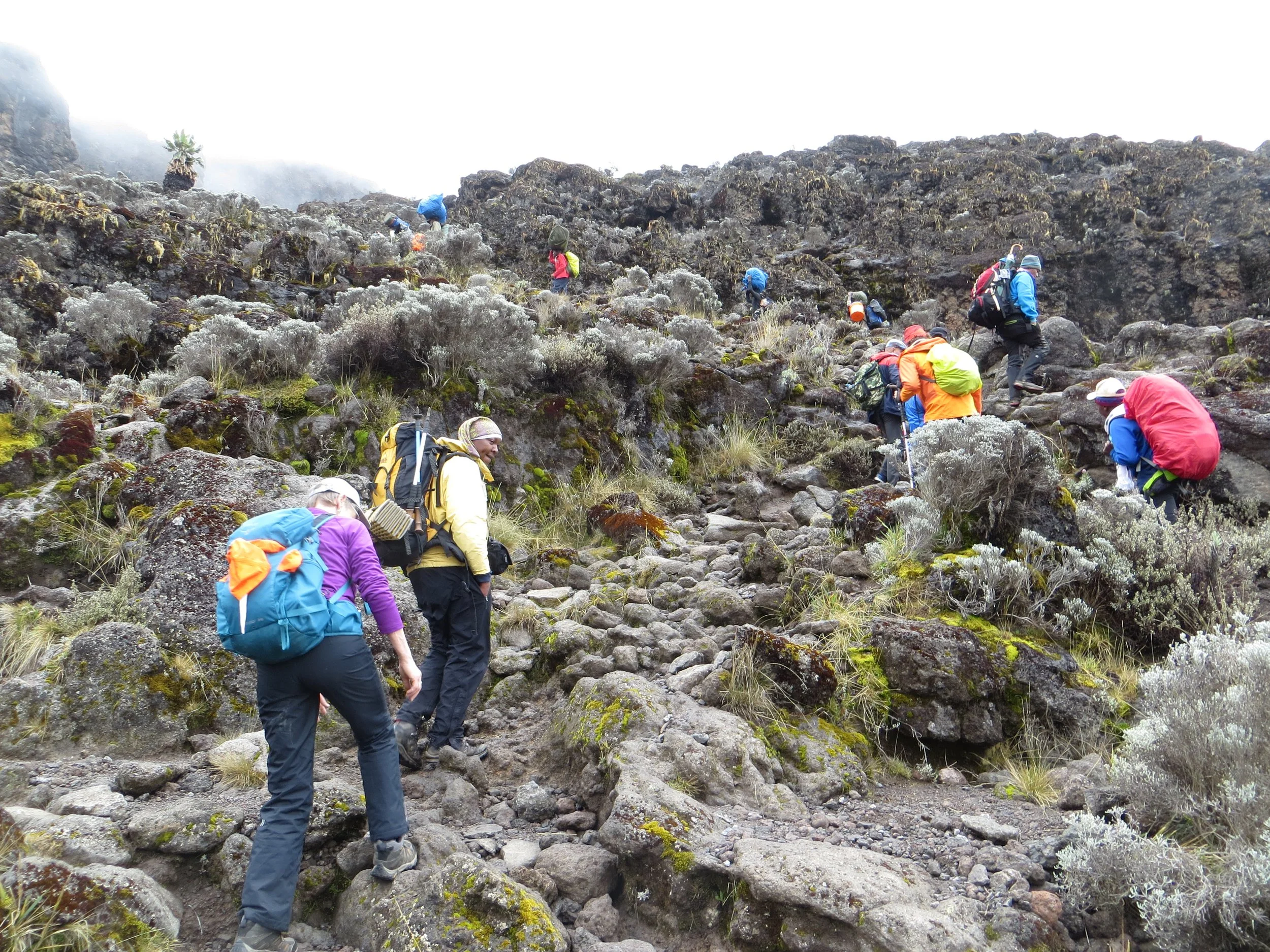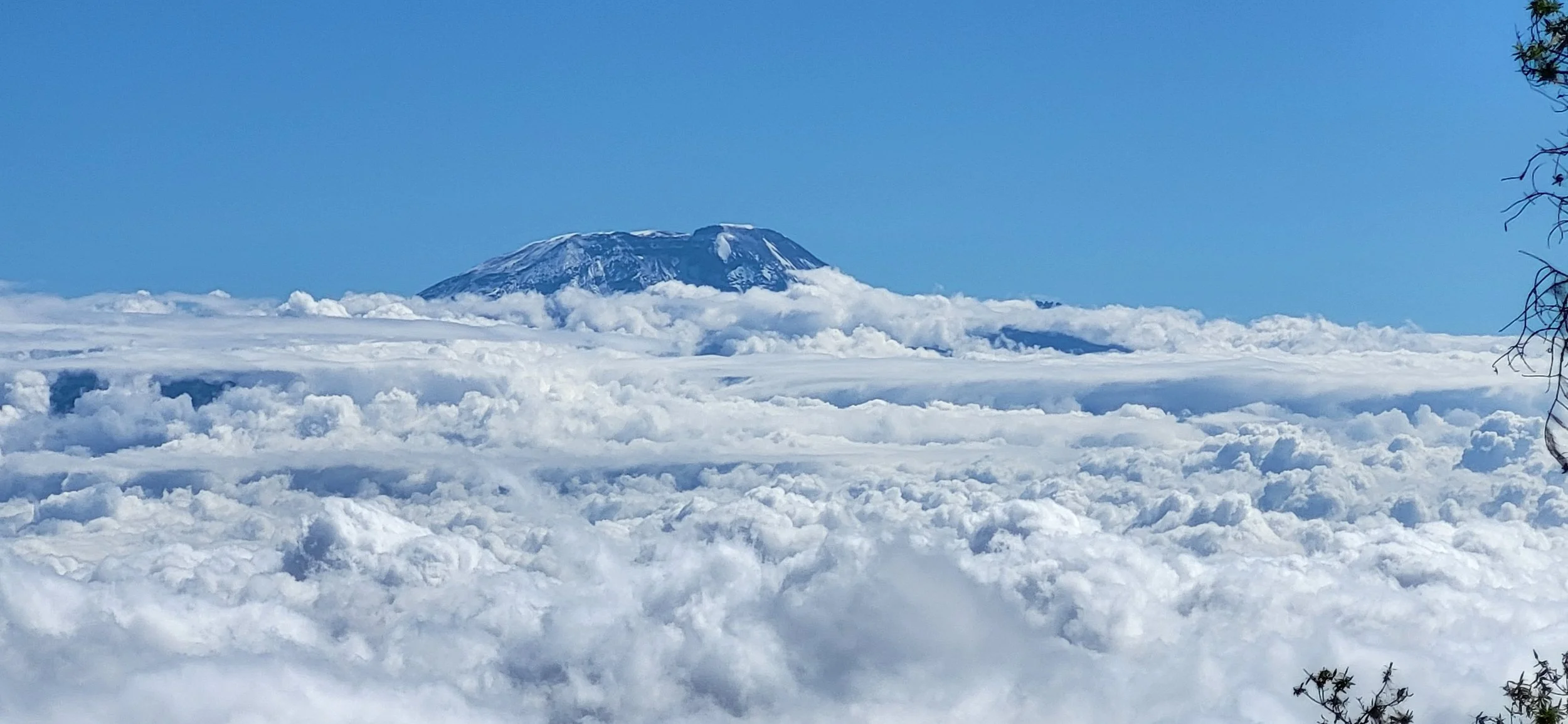
Climb Kilimanjaro and Mount Meru with KAONE
Discover the thrill of mountain trekking with KAONE, your trusted guide to Tanzania’s majestic peaks. Whether you seek the ultimate challenge of Mount Kilimanjaro, Africa's highest peak at 5,895 meters (19,341 feet), or the untamed allure of Mount Meru, Tanzania’s second-highest summit at 4,566 meters (14,980 feet), we offer expertly guided climbs that blend adventure with comfort.
-
Exceptional Expertise: Our seasoned guides provide unmatched knowledge of the mountains, ensuring a safe and unforgettable climb.
Tailored Experiences: Choose from various routes and itineraries, from rapid summit attempts to extended acclimatization treks.
Comfort and Safety: Benefit from premium gear, experienced support crews, and personalized service, making your journey as smooth as possible.
Local Insight: Gain a deeper understanding of Tanzania’s landscapes, wildlife, and culture as you ascend to Africa’s highest points.
Summiting Kilimanjaro
Challenge yourself to conquer Mount Kilimanjaro, the tallest freestanding mountain in the world. Ascend to Uhuru Peak at 5,895 meters (19,341 feet), crossing diverse landscapes and climatic zones, from lush rainforests to icy summits. Choose from six official routes, each offering unique scenery and challenges.
-
Africa’s Tallest Peak: Conquer the Roof of Africa with a summit at 5,895 meters (19,341 feet).
Diverse Route Options: From the classic Marangu route to the more remote Northern Circuit, each path presents its own adventure.
No Experience Needed: Suitable for beginners with a reasonable level of fitness and a spirit of adventure.
Diverse Landscapes: Pass through five distinct vegetation zones, each with its own climate and wildlife.
Cultural Significance: Stand on the summit of a mountain that symbolizes freedom and achievement.
-
We offer summit opportunities on all six official climbing routes:
Marangu Route: Known as the "Coca-Cola Route," this is the only route with permanent huts. Ideal for a shorter, more comfortable climb.
Machame Route: Also called the "Whiskey Route," it offers challenging terrain with spectacular views. Perfect for those seeking a rewarding adventure.
Rongai Route: Approaching from the north, this route offers a drier, quieter climb with stunning views.
Lemosho Route: Known for its scenic trails and excellent acclimatization, this western approach is a favorite for photographers.
Umbwe Route: The steepest and most direct path, recommended for experienced climbers seeking a more intense challenge.
Northern Circuit: The longest route, offering the best acclimatization and a true wilderness experience with fewer crowds.
-
Climbers choose KAONE for a personalized, safe, and deeply rewarding experience. At 5,895 meters (19,341 feet), Kilimanjaro offers a physical and emotional challenge unlike any other. It stands just 3 degrees south of the equator, making it a rare snow-capped peak in a tropical climate, with diverse ecosystems and incredible wildlife encounters.
-
Kilimanjaro is known for its diverse ecological zones, each presenting unique landscapes and wildlife:
Cultivated Zone (Up to 1700m / 5,577 ft) – Lush farmlands where coffee, bananas, and vegetables thrive.
Montane Forest (1700 to 2800m / 5,577 to 9,186 ft) – Dense rainforests with blue monkeys, black-and-white colobus monkeys, and abundant birdlife.
Moorland (3000 to 4000m / 9,842 to 13,123 ft) – High-altitude grasslands with giant lobelias and senecios, known for dramatic weather changes.
Alpine Desert (4000 to 5000m / 13,123 to 16,404 ft) – Harsh, barren terrain with extreme temperatures and sparse vegetation.
Arctic Zone (Above 5000m / 16,404 ft) – Icy, desolate landscapes with freezing nighttime temperatures.
-
Prepare for your Kilimanjaro adventure with a 2 to 4-hour walking safari in Arusha National Park, guided by an armed ranger. This safari, beginning at the lower slopes of Mount Meru at around 1700 meters (5577 feet), is perfect for acclimatization, offering a chance to spot wildlife in the lush forests and open plains.
Select Your Climbing Route
Embark on your Kilimanjaro adventure and choose the route that suits your preferences, from shorter, challenging journeys to longer treks with more acclimatization. Whichever path you take, you'll experience the unparalleled beauty of this iconic mountain.
-
The oldest and most established path, often referred to as the "Coca-Cola Route", this five or six-day ascent starts from the southeast and passes by Gilman’s Point (5,681 meters / 18,638 feet), Kili's third-highest peak. It features gentle slopes and offers an optional extra acclimatization day at Horombo Hut (3,720 meters / 12,205 feet). Unlike other routes, climbers stay in huts, allowing for a lighter travel experience.
-
Known as the "Whiskey Route", this six or seven-day ascent starts from the south, prioritizing acclimatization with the "hike high and sleep low" approach. The route includes the challenging Great Barranco Wall and features different ascent and descent paths, offering a thrilling and scenic journey. You'll reach Stella Point (5,756 meters / 18,885 feet), Kilimanjaro’s second highest peak on the Kibo volcanic cone, on your way to Uhuru Peak (5,895 meters / 19,341 feet).
-
Approaching Kilimanjaro from the west, this seven or eight-day route offers quieter trails, ample acclimatization, and high success rates. You'll traverse the Great Barranco Wall and reach Stella Point (5,756 meters / 18,885 feet) before your final push to Uhuru Peak (5,895 meters / 19,341 feet). This route is ideal for those seeking a less crowded path to the summit.
-
Starting from the north, this six or seven-day journey is one of the quieter and more remote paths to the summit. It passes by Mawenzi (5,149 meters / 16,893 feet), Kili's second-highest volcanic cone, and reaches Gilman’s Point (5,681 meters / 18,638 feet) before the final ascent to Uhuru Peak (5,895 meters / 19,341 feet). This route is known for its steady ascent and drier conditions, making it a good choice for those seeking a less crowded trek.
-
The shortest and steepest route to Kilimanjaro’s summit, this five or six-day path is known for its physical demands and rapid ascent. It includes the Great Barranco Wall and leads to Stella Point (5,756 meters / 18,885 feet) before the final push to Uhuru Peak (5,895 meters / 19,341 feet). This route is recommended for experienced climbers with a high level of fitness.
-
The longest and most scenic route to the summit, this path offers unparalleled acclimatization opportunities and stunning 360-degree views of the mountain. It's ideal for those seeking a more immersive Kilimanjaro experience.
Summiting Mount Meru
Climb Mount Meru, Tanzania's second tallest peak, either for an adventurous getaway, as preparation for the iconic Mount Kilimanjaro, or as your first trekking experience. The journey to the Socialist Peak at the volcanic Meru Crater rim takes two to four days, offering stunning views of the ash cone and, at the summit, an awe-inspiring sight of Kilimanjaro's snowy peak, Kibo. You'll follow the only established trail, the Momella Route, which takes you through lush rainforests, open savannah, and alpine deserts, providing a diverse and rewarding trekking experience.
-
Tanzania’s Second-Highest Peak: Reach the summit in just 2 to 4 days, with stunning views of Kilimanjaro and the surrounding plains.
Scenic Ascent: Climb through Arusha National Park, encountering giraffes, elephants, and diverse birdlife.
Dramatic Crater Views: Peer into the heart of Meru’s volcanic crater for a truly breathtaking experience.
Perfect Acclimatization: Prepare your body for higher altitudes before attempting Kilimanjaro.
-
Embark on the picturesque Momella Route, a four-day journey that serves both as an independent climb and an acclimatization trek before ascending Kilimanjaro. You'll start in Arusha, drive to Momella Gate, trek to Miriakamba Hut, ascend to Saddle Hut, and conquer Socialist Peak before descending back to Momella Gate. The journey concludes with a transfer back to Arusha or departure from Kilimanjaro International Airport.
-
For an even richer experience, consider a half-day walking safari in Arusha National Park before your Meru climb. This is a great way to encounter diverse wildlife and stunning landscapes while adjusting to higher altitudes, making your summit attempt more enjoyable and successful.
Best Times to Climb
Choosing the right season is essential for a safe and enjoyable climb. While both Kilimanjaro and Meru can be climbed year-round, the best months are January, February, and September for stable weather and clear skies. Warm and dry months are recommended. For cooler trails and crisp mountain air, June and July are ideal, while the warmest period is mid-December to mid-March. For the driest conditions and panoramic views, consider trekking from August to mid-October.
-
Ascend during the most stable weather months for clear skies and warm temperatures, ensuring a comfortable and rewarding summit experience. Ideal months include January, February, and September.
-
Enjoy cooler trails and crisp mountain air in June to July, or take advantage of the driest conditions from August to mid-October for firm trails and panoramic views.
-
Embrace Tanzania’s warmest trekking season, offering quieter routes and stunning vistas for a serene yet challenging adventure. Perfect for those climbing between mid-December and mid-March.
Pricing



